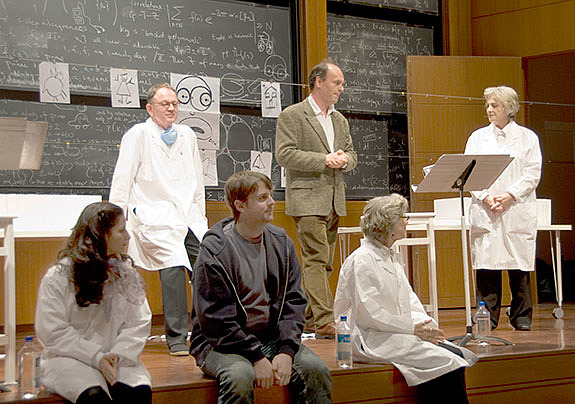Mathematical Sciences Investigation (MSI): The Anatomy of Integers and Permutations

Andrew Granville, a Member in the School of Mathematics, describes the origins and making of an experimental work that blurred the boundaries between pure mathematics, film, and live performance. It premiered in Wolfensohn Hall on December 12.
Mathematics involves a rich language, invoking precise definitions that deter most people who are not well-trained in its subtleties. Although there is a fine tradition of “popularizations,” these are always subject to the dilemma that writing at too high a level discourages readership and at too low a level does not do justice to the material. The question remains as to how to disseminate high-level mathematics to a wider audience. When my latest idea for an expository article took shape, I wondered whether it could be presented in a nontraditional way to attract a different, wider audience.
The mathematics I was interested in explaining involved the underlying composition of two central mathematical objects, integers and permutations, and the surprising revelation that in many ways their structure seems very similar—so similar, in fact, that they are almost identical. This reminded me of an episode of the TV series CSI: Crime Scene Investigation in which two different-looking people proved to be twins. Autopsies yielded the crucial evidence; why not construct a similar revelation from autopsies of integers and permutations? We set out to create a fantasy world that would slowly reveal various mathematical properties, just as evidence is slowly revealed in CSI.
Could just-out-of-reach mathematical ideas and an allegorical story explaining the mathematics hold an audience’s interest? Certainly, the characters would need to be compelling. Fortunately, mathematical history has no shortage of interesting characters: Karl Friedrich Gauss, Sophie Germain, John von Neumann, Alexander Groethendieck . . . By incorporating some of their history, other issues could be addressed—how mathematicians work together; student-teacher as well as peer relationships; the role of women in mathematics today; and mathematics as structure-building research vs. problembased investigation.
I approached my sister, who is a screenwriter, for help. She wove my ideas into a storyline, never cutting the mathematics, but asking me to shape it to different situations. Our first draft of Mathematical Sciences Investigation was critiqued by other mathematicians who enjoy writing expository mathematics, and duly revised. We then wanted to see how it would work as a live reading by professional actors in front of a mathematical audience. I ran the idea by Peter Sarnak, a Professor in the School of Mathematics, and Peter Goddard, the Director of the Institute, who kindly agreed to host the reading in Wolfensohn Hall.
For the performance, we needed some visual language, short of making a movie! Michael Spencer, Director of Performance Design and Practice at Central St Martin’s College of Art and Design in London, brought a distinctive vision to our script. He suggested the use of paper corpses to represent the research—thus the autopsies would literally reveal the mathematics.
Robert Schneider, the lead singer and composer for the band The Apples in Stereo and a keen amateur mathematician, composed an original score for MSI that he performed live along with clarinetist Alex Kontorovich, a Member in the School of Mathematics, and cellist Heather McIntosh. The instruments played four different measures—at the second, third, fifth, and seventh beats—all primes. The missing beats were at eleven, thirteen ... exactly the primes between ten and fifty, thus turning the Sieve of Eratosthenes into haunting music.
Six actors from New York City read our screenplay, after working with us for just one day. They did remarkably well with so much technical language, so many difficult names to navigate, and sounding as if they knew what they were talking about! We were delighted by the positive response at the post-performance question-and-answer session and at the reception.
We are now revising the script to prepare for other performances over the coming year, which will take MSI to a wider mathematical audience, and are working on a related graphic novel for Princeton University Press.